Storage and disposal
Weeping wall systems
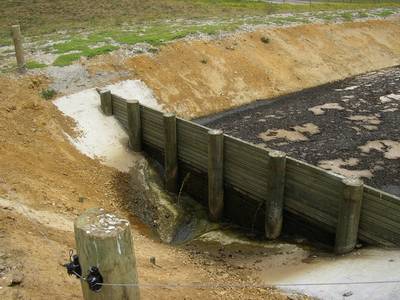 Weeping wall system.
Weeping wall system.
Weeping walls are designed to remove solids from farm dairy effluent. The removal of solids before irrigating means:
- Solids don't have to be removed annually from the first pond.
- Lower pumping costs.
- Better irrigator performance.
- Elimination of blockages in low application rate sprinklers.
Weeping walls eliminate the need for gravel traps, many of which do not work well and require routine cleaning.
The system consists of sludge beds, which are one metre deep ponds that sit behind slatted timber walls. Two sludge beds and two weeping walls are often used for each installation so when one bed is full it is left to dry and the solids can then be removed and spread onto pasture or crop paddocks.
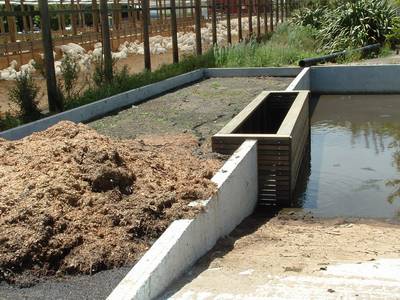
The wall is built by installing posts at one metre centres and fastening 50mm x 50mm slats to the posts. There are specific gaps between the timbers depending on the effluent source, i.e. dairy yards or feed pads etc and the top side of each of the slats is tapered to allow more efficient liquid effluent to flow through the wall.
A weeping wall can be used with a sump and pump when the level of the storage pond is above the level of the sludge bed and the wall.
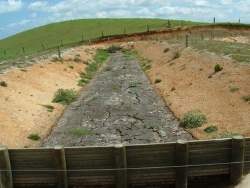 Sludge beds
Sludge beds
Each sludge bed should have a minimum of 30 cubic metres of volume for every 100 cows. (Note: more volume is required if effluent from a feed or standoff pad is to be treated. The sludge bed is one metre deep and has an internal batter of two to one (2:1). The floor of the sludge bed should be level and the concrete apron under the weeping wall must be slightly lower than the bottom of the sludge bed.
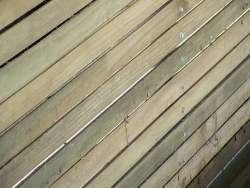 Weeping wall design
Weeping wall design
Correct design and installation is critical if a weeping wall is to work effectively. The required wall area is typically one square metre for every 100 cows but with a minimum of five square metres for each wall. The recommended gap between slats for effluent from the dairy is eight to 10mm and for feed pads 15 to 18mm.
It's recommended that the slats are fixed to the posts when they are saturated as dry slats expand when they get wet and will therefore close the gap.
The bottom of the wall and the concrete apron must be above the level of the liquid in the pond to allow the sludge to dry. A pipe or a concrete channel is also required to carry effluent to the pond to prevent erosion below the weeping wall.
Weeping wall maintenance
Sludge beds must be cleaned annually with the retained solids spread on pasture or crop paddocks. The weeping walls should be pressure washed while the sludge beds are empty. Any broken slats or knot holes can be repaired using plywood strips.
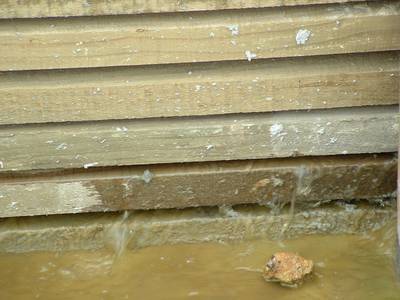
Contingency storage ponds
Applied effluent must be retained in the pasture root zone so effluent should not be applied to pasture when soils are at or near saturation. Unfortunately, Northland soils are often saturated from May through to October.
Research has proven that up to 80 percent of effluent applied to saturated soils runs off to surface or ground water.
Dairy industry guidelines recommend a minimum storage volume of five cubic metres per cow (5m³/cow) for spring calving herds in Northland. This volume is for effluent from the dairy and yard only and assumes stormwater is diverted when the yard is clean. It also assumes the ponds are emptied in autumn and the only input over winter is rainfall on the ponds.
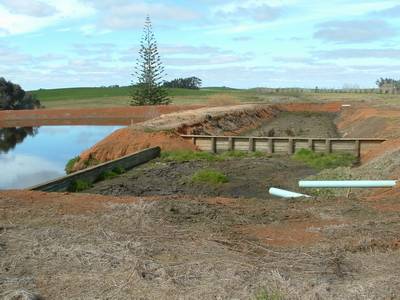 Weeping wall with sludge bed and pond.
Weeping wall with sludge bed and pond.
The storage volume must also be increased when:
- There's winter milking through the dairy shed;
- The yard has been used for standoff over winter;
- There is an open standoff or feedpad; or
- Stormwater is not routinely diverted.
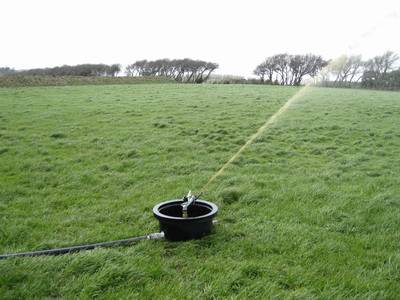 Low application rate sprinklers
Low application rate sprinklers
Ongoing blockages in the small diameter nozzles found in low application rate sprinklers have traditionally created management problems. However, low application rate sprinklers are now available with a choice of nozzle sizes at eight, nine and 10mm.
At 20psi and with a 9mm nozzle these sprinklers can spread as much as 3700 litres an hour over 850 square metres at an application rate of 4.43mm an hour.
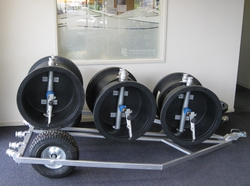 The sprinklers are fitted to pods – plastic tubs – and up to eight pods can be connected to a single mainline depending on pump capacity and the size of the mains. Volumes and the area that's wetted both increase with pump capacity and pressure.
The sprinklers are fitted to pods – plastic tubs – and up to eight pods can be connected to a single mainline depending on pump capacity and the size of the mains. Volumes and the area that's wetted both increase with pump capacity and pressure.
The sprinklers can operate at up to 100psi and the pods can easily be moved by towing with a quad bike.
A number of Northland farmers are operating sprinklers from ponds using gravity rather than a pump, with good results.
Further information
For design criteria or to see a weeping wall, please contact the Northland Regional Council Farm Dairy Effluent team on 0800 002 004.
